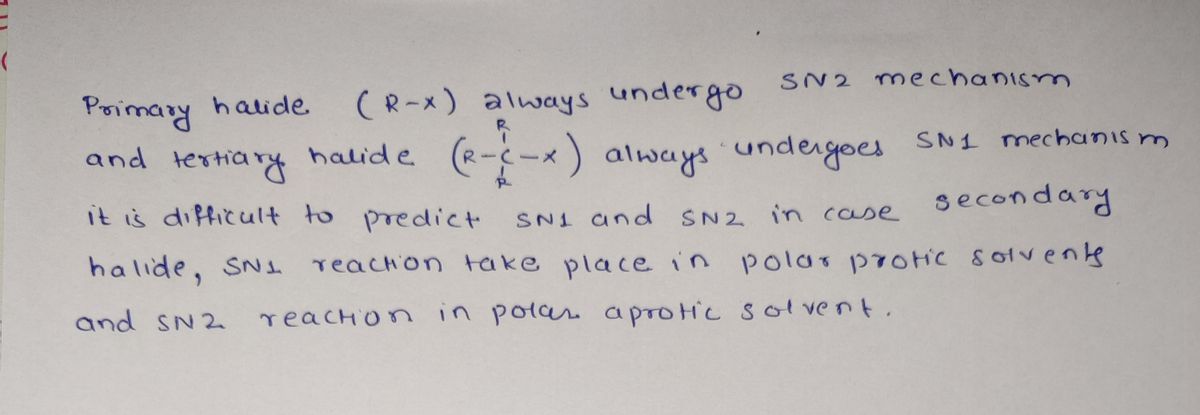Problem 1: Draw the product of nucleophile substitution , and determine the likely mechanism ( SN' or SN? ): H3C° `CH3 a- CH3OH + Br b- H2O + H,c-G CH, CH, с- СH;ОН + Problem 2: What is likely mechanism of nucleophilic substitution for each halide ? Br H3C
Problem 1: Draw the product of nucleophile substitution , and determine the likely mechanism ( SN' or SN? ): H3C° `CH3 a- CH3OH + Br b- H2O + H,c-G CH, CH, с- СH;ОН + Problem 2: What is likely mechanism of nucleophilic substitution for each halide ? Br H3C
Chemistry
10th Edition
ISBN:9781305957404
Author:Steven S. Zumdahl, Susan A. Zumdahl, Donald J. DeCoste
Publisher:Steven S. Zumdahl, Susan A. Zumdahl, Donald J. DeCoste
Chapter1: Chemical Foundations
Section: Chapter Questions
Problem 1RQ: Define and explain the differences between the following terms. a. law and theory b. theory and...
Related questions
Question
Solve¿

Transcribed Image Text:۹ سبتمبر
م الخميس
+ :
Polar protic solvents such as water favor SN' reactions, which produce both a cation and an
anion during reaction. These solvents are capable of stabilizing the charges on the ions formed
during solvation. Because SN² reactions occur via a concerted mechanism (a mechanism which
takes place in one step, with bonds breaking and forming at the same time) and no ions form,
polar protic solvents would have little effect upon them. Solvents with low dielectric constants
tend not to stabilize ions and thus favor SN² reactions. Conversely, solvents of high dielectric
constants stabilize ions, favoring SN' reactions.
In general, good leaving groups are those capable of forming stable ions or molecules upon
displacement from the original molecule. Conversely, poor leaving groups form ions of
moderate stability.
poor to
bases, such as OH , NH2 , and RO ¯, make poor leaving groups.
Water, which is less basic than a hydroxide ion, is a better leaving group. Poor bases usually
make good leaving groups. A poor base is an ion or group in which the electrons are tightly
bound to the molecule due to high electronegativity or resonance.
Problem 1:
Draw the product of nucleophile substitution , and determine the likely mechanism ( SN' or
SN² ):
H3C
CH3
a- CH3OH
+
Cl
b- H2O
+
Br
-CH,
CH,
H,C
с- CН,ОН +
Problem 2:
What is likely mechanism of nucleophilic substitution for each halide ?
Br
H3C
17
133
14
Expert Solution
Step 1

Step by step
Solved in 2 steps with 2 images

Knowledge Booster
Learn more about
Need a deep-dive on the concept behind this application? Look no further. Learn more about this topic, chemistry and related others by exploring similar questions and additional content below.Recommended textbooks for you

Chemistry
Chemistry
ISBN:
9781305957404
Author:
Steven S. Zumdahl, Susan A. Zumdahl, Donald J. DeCoste
Publisher:
Cengage Learning

Chemistry
Chemistry
ISBN:
9781259911156
Author:
Raymond Chang Dr., Jason Overby Professor
Publisher:
McGraw-Hill Education

Principles of Instrumental Analysis
Chemistry
ISBN:
9781305577213
Author:
Douglas A. Skoog, F. James Holler, Stanley R. Crouch
Publisher:
Cengage Learning

Chemistry
Chemistry
ISBN:
9781305957404
Author:
Steven S. Zumdahl, Susan A. Zumdahl, Donald J. DeCoste
Publisher:
Cengage Learning

Chemistry
Chemistry
ISBN:
9781259911156
Author:
Raymond Chang Dr., Jason Overby Professor
Publisher:
McGraw-Hill Education

Principles of Instrumental Analysis
Chemistry
ISBN:
9781305577213
Author:
Douglas A. Skoog, F. James Holler, Stanley R. Crouch
Publisher:
Cengage Learning

Organic Chemistry
Chemistry
ISBN:
9780078021558
Author:
Janice Gorzynski Smith Dr.
Publisher:
McGraw-Hill Education

Chemistry: Principles and Reactions
Chemistry
ISBN:
9781305079373
Author:
William L. Masterton, Cecile N. Hurley
Publisher:
Cengage Learning

Elementary Principles of Chemical Processes, Bind…
Chemistry
ISBN:
9781118431221
Author:
Richard M. Felder, Ronald W. Rousseau, Lisa G. Bullard
Publisher:
WILEY